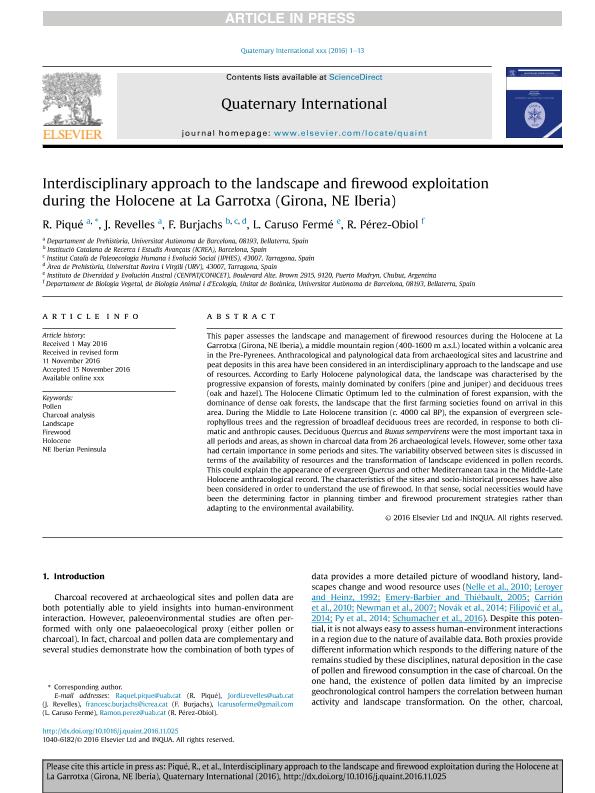Mostrar el registro sencillo del ítem
dc.contributor.author
Piqué, R.
dc.contributor.author
Revelles, J.
dc.contributor.author
Burjachs, F.
dc.contributor.author
Caruso, Laura Lihue

dc.contributor.author
Pérez Obiol, R.
dc.date.available
2017-12-18T20:14:21Z
dc.date.issued
2017-03-01
dc.identifier.citation
Pérez Obiol, R.; Caruso, Laura Lihue; Burjachs, F.; Piqué, R.; Revelles, J.; Interdisciplinary approach to the ladscape and firewood exploitation during the Holocene at La Garrotxa (GIirona, NE Iberia); Elsevier; Quaternary International; 1-3-2017; 1-13
dc.identifier.issn
1040-6182
dc.identifier.uri
http://hdl.handle.net/11336/30947
dc.description.abstract
This paper assesses the landscape and management of firewood resources during the Holocene at La Garrotxa (Girona, NE Iberia), a middle mountain region (400-1600 ma.s.l.) located within a volcanic area in the Pre-Pyrenees. Anthracological and palynological data from archaeological sites and lacustrine and peat deposits in this area have been considered in an interdisciplinary approach to the landscape and use of resources. According to Early Holocene palynological data, the landscape was characterised by the progressive expansion of forests, mainly dominated by conifers (pine and juniper) and deciduous trees (oak and hazel). The Holocene Climatic Optimum led to the culmination of forest expansion, with the dominance of dense oak forests, the landscape that the first farming societies found on arrival in this area.During the Middle to Late Holocene transition (c. 4000 cal BP), the expansion ofevergreen sclerophyllous trees and the regression of broadleaf deciduous trees are recorded, in response to both climatic and anthropic causes. Deciduous Quercus and Buxus sempervirens were the most important taxa in all periods and areas, as shown in charcoal data from 26 archaeological levels. However, some other taxa had certain importance in some periods and sites. The variability observed between sites is discussed in terms of the availability of resources and the transformation of landscape evidenced in pollen records. This could explain the appearance of evergreen Quercus and other Mediterranean taxa in the Middle-Late Holocene anthracological record. The characteristics of the sites and socio-historical processes have also been considered in order to understand the use of firewood. In that sense, social necessities would have been the determining factor in planning timber and firewood procurement strategies rather than adapting to the environmental availability.
dc.format
application/pdf
dc.language.iso
eng
dc.publisher
Elsevier

dc.rights
info:eu-repo/semantics/openAccess
dc.rights.uri
https://creativecommons.org/licenses/by-nc-sa/2.5/ar/
dc.subject
Pollen
dc.subject
Charcoal Analysis
dc.subject
Landscape
dc.subject
Firewood
dc.subject
Holocene
dc.subject
Ne Iberian Peninsula
dc.subject.classification
Historia

dc.subject.classification
Historia y Arqueología

dc.subject.classification
HUMANIDADES

dc.title
Interdisciplinary approach to the ladscape and firewood exploitation during the Holocene at La Garrotxa (GIirona, NE Iberia)
dc.type
info:eu-repo/semantics/article
dc.type
info:ar-repo/semantics/artículo
dc.type
info:eu-repo/semantics/publishedVersion
dc.date.updated
2017-12-04T18:08:42Z
dc.journal.pagination
1-13
dc.journal.pais
Países Bajos

dc.journal.ciudad
Amsterdam
dc.description.fil
Fil: Piqué, R.. Universitat Autònoma de Barcelona; España
dc.description.fil
Fil: Revelles, J.. Universitat Autònoma de Barcelona; España
dc.description.fil
Fil: Burjachs, F.. Institució Catalana de Recerca i Estudis Avançats; España. Institut Català de Paleoecologia Humana i Evolució Social; España. Universitat Rovira I Virgili; España
dc.description.fil
Fil: Caruso, Laura Lihue. Consejo Nacional de Investigaciones Científicas y Técnicas. Centro Científico Tecnológico Conicet - Centro Nacional Patagónico. Instituto de Diversidad y Evolución Austral; Argentina
dc.description.fil
Fil: Pérez Obiol, R.. Universitat Autònoma de Barcelona; España
dc.journal.title
Quaternary International

dc.relation.alternativeid
info:eu-repo/semantics/altIdentifier/url/www.sciencedirect.com/science/article/pii/S1040618216305158
dc.relation.alternativeid
info:eu-repo/semantics/altIdentifier/doi/http://dx.doi.org/10.1016/j.quaint.2016.11.025
Archivos asociados
